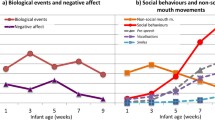Abstract
Subjects filled out questionnaires and were individually observed interacting with an 8-to-12-month-old infant in a waiting room. Hidden observers recorded the frequency of ignoring, responsiveness to infant bids, and of social bids to the infant. Analyses revealed that older girls ignored more, made fewer bids, and responded less than younger girls did. However, chronological age was highly correlated with measures of biological and social maturity. Multiple regression analyses were used to determine which of these factors best predicted the developmental decline in baby responsiveness. Multiple regressions showed that social maturity was the best predictor of the number of bids to the infant, followed by the development of secondary sex characteristics and menarcheal status (R=.44). Social maturity, babysitting experience, and menarcheal status were the significant predictors of ignoring (R=.48), while menarcheal status, development of secondary sex characteristics, and babysitting experience predicted responsiveness (R=.49). Possible reasons for the decreased interest in infants are discussed, as are the implications for research using baby responsiveness as a measure of sex-role-related changes in adolescence.
Similar content being viewed by others
References
Berman, P. W. Are women predisposed to parenting: Developmental and situational determinants of sex differences in responsiveness to the young. Psychological Bulletin, 1980, 88, 668–695.
Elkind, D. Strategic interaction in early adolescence. In J. Adelson (Ed.), Handbook of adolescent psychology. New York: Wiley, 1980.
Faiman, C., & Winter, J. Go nadotropins and sex hormone patterns in puberty. In M. Grumback, G. Grave, & F. Mayer (Eds.), Control of the onset of puberty. New York: Wiley, 1974.
Feldman, S. S., & Nash, S. C. Interest in babies during young adulthood. Child Development, 1978, 49, 617–622.
Feldman, S. S., & Nash, S. C. Changes in responsiveness to babies during adolescence. Child Development, 1979, 50, 942–949. (a)
Feldman, S. S., & Nash, S. C. Understanding sex differences in responsiveness to babies among mature adults. Developmental Psychology, 1979, 15, 430–435. (b)
Feldman, S. S., Nash, S. C., & Cutrona, C. The influence of age and sex on responsiveness to babies. Developmental Psychology, 1977, 13, 675–676.
Fenigstein, A., Scheier, M. F., & Buss, A. H. Public and private self-consciousness: Assessment and theory. Journal of Consulting and Clinical Psychology, 1975, 43, 522–527.
Frodi, A. M., & Lamb, M. E. Sex differences in responsiveness to infants: A developmental study of psychophysiological and behavioral responses. Child Development, 1978, 49, 1182–1188.
Fullard, W., & Reiling, A. M. An investigation of Lorenz' “babyness.” Child Development, 1976, 47, 1191–1193.
Morris, N. M., & Udry, J. R. Validation of a self-administered instrument to assess stage of adolescent development. Journal of Youth and Adolescence, 1980, 9, 271–280.
Nash, S. C., & Feldman, S. S. Sex role and sex-related attributions: Constancy or change across the family life cycle? In M. E. Lamb & A. L. Brown (Eds.), Advances in developmental psychology (Vol. 1). Hillsdale, N.J.: Lawrence Erlbaum, 1982.
Spence, J. T., Helmreich, R. L., & Stapp, J. A short version of the Attitudes toward Woman Scale (AWS). Bulletin of the Psychonomic Society. 1973, 2, 219–220.
Spence, J. T., Helmreich, R., & Stapp, J. The Personal Attributes Questionnaire: A measure of sex-role stereotypes and masculinity-feminity. JSAS Catalog of Selected Documents in Psychology, 1974, 4, 43. (Ms. No. 617).
Tanner, J. Fetus into man. Cambridge, Mass.: Harvard University Press, 1978.
Author information
Authors and Affiliations
Additional information
This research was supported by grants from the Riksbankens Jubileumsfond and the Humanistisk-Samhällsvetenskapliga Forskiningsradet of Sweden to Ann M. Frodi. The authors are grateful to Sharon Bienstock for her assistance.
Rights and permissions
About this article
Cite this article
Frodi, A.M., Murray, A.D., Lamb, M.E. et al. Biological and social determinants of responsiveness to infants in 10-to-15-year-old girls. Sex Roles 10, 639–649 (1984). https://doi.org/10.1007/BF00287271
Issue Date:
DOI: https://doi.org/10.1007/BF00287271




